10 Types of Ducks Found in Texas (With Pictures)
Last Updated on
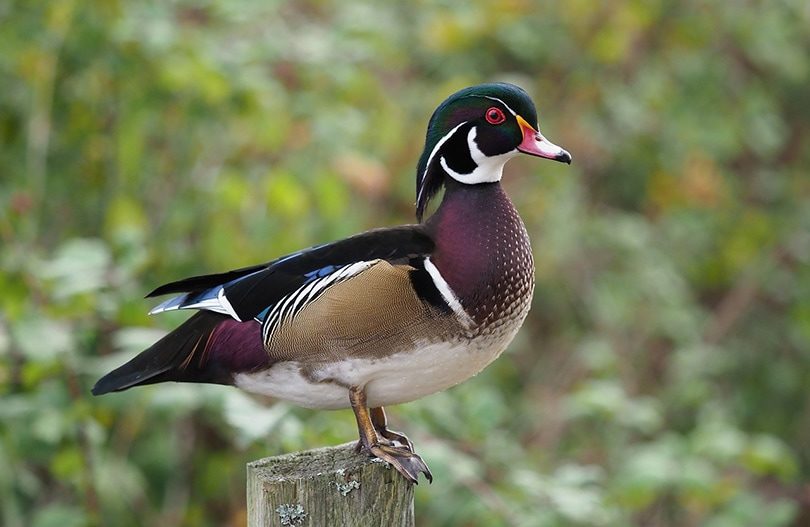
Texas is home to a wide range of waterfowl like ducks and geese. If you enjoy watching ducks and wonder what duck breeds live in Texas, you’ve come to the right place! We’ve put together this list of the 10 duck breeds available in Texas, so you’ll know which ones are in the Lone Star State.
If you head to almost any water habitat in Texas, you’re likely to see at least a few of the following breeds swimming around, so keep your eyes open.

The 10 Duck Breeds Found in Texas
1. Mallard

You’re probably not surprised to see mallards on this list of ducks in Texas because these ducks are commonly found across the state, and they are easy to recognize.
Male mallards have bright green heads, white-collars around the neck, dark brown chests, a yellow bill, white rumps, and tails tipped in white. Like other duck breeds, female mallards are less showy as these ducks are mottled brown with orange or brown bills.
Both the male and female mallards have purplish-blue secondary wing feathers that are visible when they’re flying or standing on land. You can spot mallards all over Texas and usually without looking too hard.
The main reason mallards are so widespread in Texas and elsewhere is that they’re not extremely scared of humans. You can spot mallards in ponds and lakes across Texas and even in backyard swimming pools at times!
2. Gadwall

Unlike showy mallards that are easily recognized, gadwalls are a bit more challenging to identify, even though there are many of these ducks in Texas. The males have patterned feathers on their bodies that are a mix of grays, browns, and blacks with white-tipped scales. The males also have brown heads with gray or black bills.
Female gadwalls look a lot like female mallards, but these ducks have a more mottled brown coloring to their feathers with dark orangey black bills. Both the males and females have a white patch on their wings you can see when they’re in flight.
You’re likely to find gadwalls around small ponds with lots of vegetation. You typically won’t see these ducks taking a dip in a neighborhood pool because they’re not as human-friendly as mallards!
An interesting thing about gadwalls is that these ducks tend to steal food from diving ducks when they pop up on the surface of the water. Male gadwalls also make funny burp-like noises. If you think you hear ducks burping on or near a body of water, there are likely gadwalls nearby.
3. American Wigeon
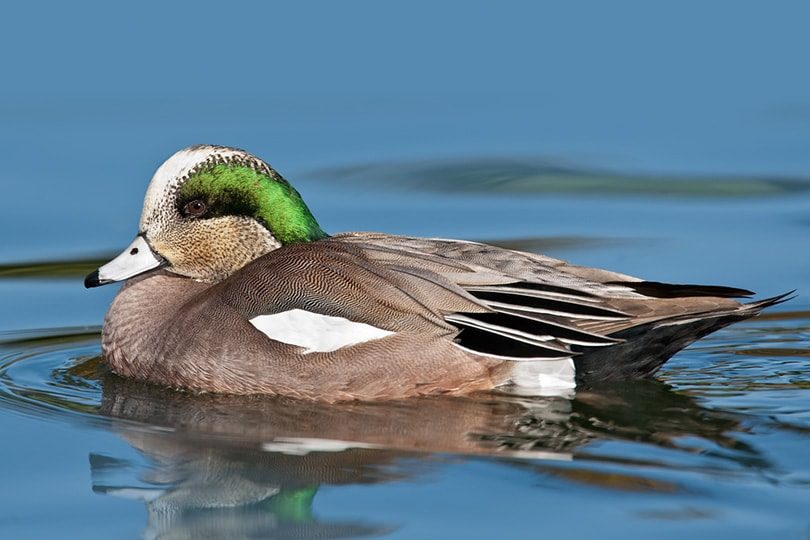
Because American wigeons are shy ducks, you’re most likely to spot them on small, quiet bodies of water in Texas and remote marshes. These ducks have compact bodies that sit low in the water. Male American wigeons are mostly brown, but they have a distinctive green band of color behind their eyes and a white crown on top of their heads.
Female American wigeons are less showy and have all-brown bodies with grayish-colored heads. Both the males and females have short bills used to pluck vegetation with ease. If you want to see American wigeons up close, you’ll have to be quiet and approach these ducks with care because they’re easily frightened.
The best way to identify this duck breed is by listening. Male American wigeons make a “whew-whew-whew” sound that sounds like a kazoo while the females produce a harsh quack.
4. Northern Shoveler
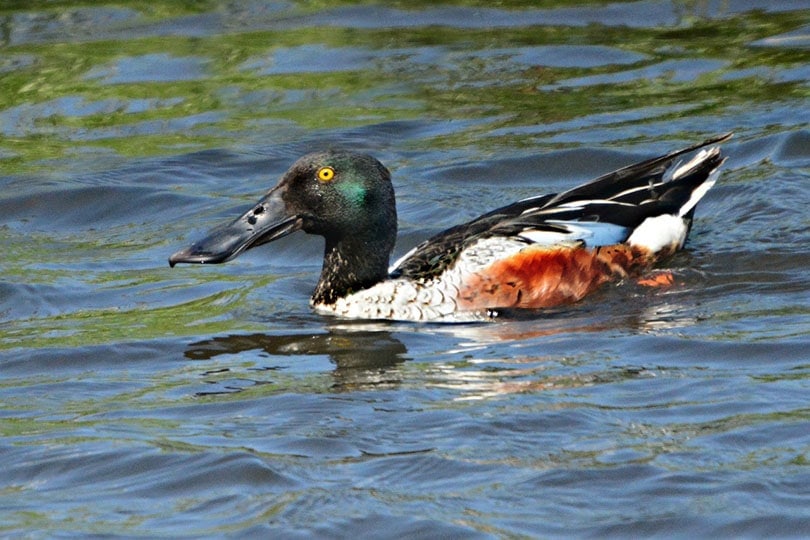
Many people mistakenly identify northern shovelers as mallards because the two breeds look similar. However, upon closer inspection, the northern shoveler has a very different bill than a mallard that’s both wider and larger.
The northern shoveler holds true to its name as this duck uses that enormous spoon-shaped bill like a shovel to pick its food out of mud and sand. This duck loves eating tiny crustaceans, mollusks, and bugs of all sorts. The bill is covered with dozens of tiny projections on the edges that filter the sand and muck from the food it eats.
Male northern shovelers have green heads, black backs, reddish-brown flanks, a broad black bill, and yellow eyes. The females are primarily brown, although you can see a bluish patch on the shoulder area if you look closely. And, like the males, the females have the same wide bills, but the bills are brownish colored and not black like their male counterparts.
Male northern shovelers make a distinctive guttural sound while females make a nasally quack. It’s not uncommon to spot flocks of northern shovelers swimming in lakes close together to help stir up food. If you ever spot a flock of big-billed ducks on a Texas lake that look like they’re having a party swimming around in circles, you’ll likely be looking at a flock of northern shovelers looking for their next meal.
5. Northern Pintail

It’s easy to identify a flock of northern pintails because these slender ducks have elongated necks and long pointy tails that stick out, even when they’re flying. The male of this duck breed has a gray body, white chest and throat, and a reddish-brown head. The female has a tan head and a mostly brown body.
Northern pintails don’t like being around people, so the best place to look for these ducks is in remote ponds, lakes, and marshlands. But you won’t spot these ducks far from shore, as they stick close to the edges of the water to hide among the plants as they forage for food. You can spot northern pintails on land as these ducks like to look for food in fields where they forage for leftover grains.
Male northern pintails make a whistling sound while the females make a rather quacking noise. These ducks are great flyers that can reach speeds of up to 45 miles per hour or even more when migrating.
6. Wood Duck

The wood duck is a very colorful breed that you may spot in or around a body of water or maybe even in a tree! These ducks make their nests in abandoned tree cavities because they prefer being up and off the ground when having young. If you’re lucky enough to spot a wood duck nesting in a tree, don’t be alarmed if it suddenly leaps to the ground because this duck can make long jumps and quickly escapes to safer ground when startled.
The wood duck is one of the most colorful ducks in the world as it’s a natural beauty. The male wood duck has intricate plumage with a glossy green crested head with white stripes, chestnut chest with white flecks, and red piercing eyes. The female wood duck is much more subdued with a gray-brown body and white speckled chest. Both sexes have a boxy body, broad wings, and a long broad tail.
Most often, wood ducks are spotted in Texas in small groups, keeping far away from other waterfowl. These ducks can be found in ponds, small lakes, wooded swamps, marshes, and streams.
The head of a wood duck jerks back and forth when swimming, much like how pigeons walk. Both the male and female wood duck make a loud “wheet-wheet” squealing sound when alarmed and when calling one another.
7. Green-Winged Teal

Green-winged teals are small dabbling ducks with short necks and small bills. The males have grayish bodies with a narrow white vertical stripe running from the head to the shoulder. The males have dark reddish-brown heads with a wide green swoop from the eye to the back of the neck. The females are mostly brown with a streak of yellow on the tail.
You can spot green-winged teals along coastal marshes and rice fields of Texas. These ducks feed on grasses, aquatic insects, mollusks, crustaceans, and tadpoles. You can also find these ducks in farm fields where they feed on seeds, wheat, oats, and buckwheat.
Female green-winged teals make a repeated shrill quacking sound during courtship and when trying to distract predators. The males let out a clear whistling call when courting females and do some persistent quacking when predators are nearby.
8. Blue-Winged Teal
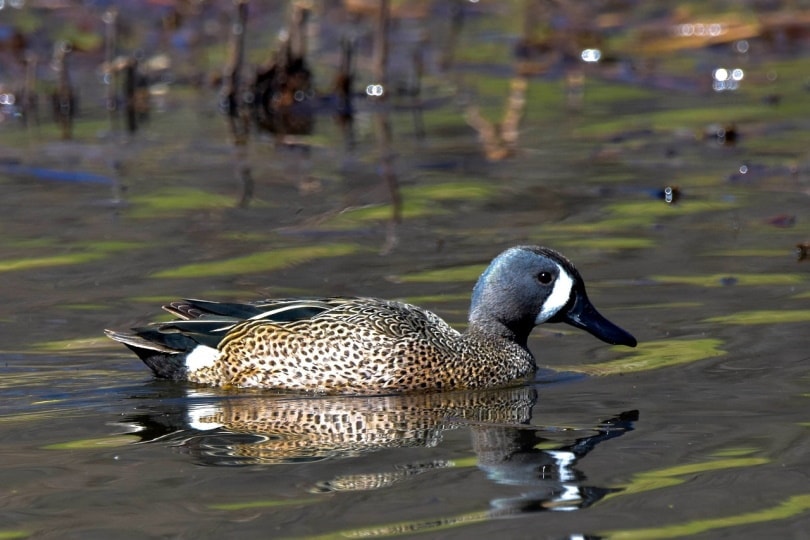
You can identify a male blue-winged teal by its bluish head with a white band in front of the eye. The males also have black wings and black bills with mostly brown bodies with black spots. The females are mostly brown with a dark line under the eye and a patch of dark brown on their heads.
Blue-winged teals get their name from their blue shoulder patch that’s only visible when these ducks fly. You can find these ducks in shallow wetlands all over Texas where they feed on grasses, aquatic insects, mollusks, and tadpoles. You won’t spot blue-winged Teals in a farm field because these ducks seldom feed away from water.
These are long-distance migrating ducks that can fly all the way to South America for the winter. During mating and when alarmed, a male blue-winged tail lets out a loud high whistling sound while the female emits loud quacks. These ducks are small, fast in flight, and ducks that don’t like being around people.
9. Cinnamon Teal
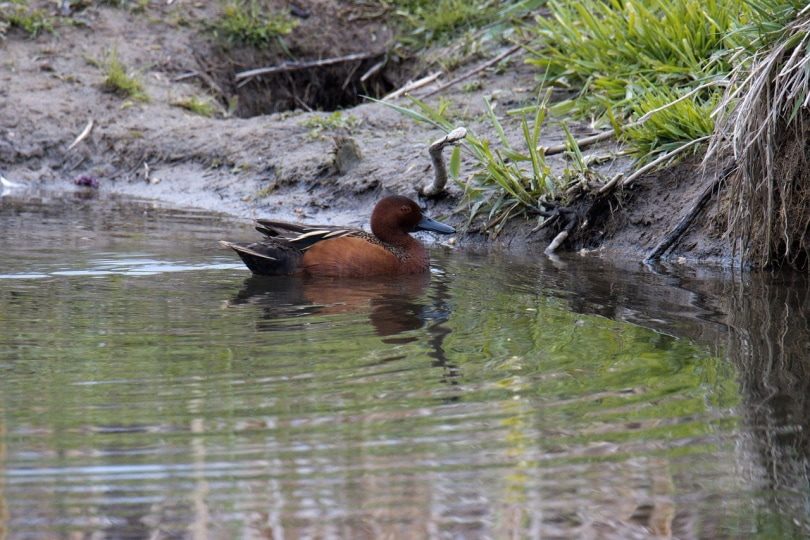
If you guess that cinnamon teals are cinnamon-colored, you’re right! The male cinnamon teal has a cinnamon-colored body, a thick long black bill, and red eyes. The female is mottled brown overall with black eyes and a large black bill. When flying, the male cinnamon teal shows off gorgeous blue and green patches on its wings.
These waterfowl are commonly seen in large wetlands in Texas where they stick to the edge of the water foraging among reeds. These ducks eat all kinds of vegetation, aquatic insects, and small crustaceans. Cinnamon teals tend to stick with their own kind and don’t like mingling with other ducks.
If a female cinnamon teal has hatchlings, she will protect them from approaching predators by pretending to have a broken wing, making herself look like easy prey. Both the male and female cinnamon teal produce a screechy quack during courtship and when warding off predators.
10. Lesser Scaup

The lesser scaup is a medium-sized duck with a small peak of feathers at the rear end of its head. This duck has a short neck, beautiful yellow eyes, and a bluish beak. The males are black and white with a purplish-green sheen on their heads. The females have mostly brown bodies with darker brown heads that are marked in white next to the bill.
Lesser scaups are diving ducks that can be found in flocks near lakes, wetlands, and rivers across Texas, and they’re often spotted with other duck breeds. Lesser Scaups are not very vocal. The males produce a low weak gurgling sound during courtship while the females produce a low-pitched guttural “brrtt-brrtt” sound.
These ducks eat aquatic invertebrates like mollusks, insects, and crustaceans, and sometimes aquatic plants and seeds. They’re often seen foraging in shallow water while using their feet to propel themselves underwater.

In Conclusion
We hope you enjoyed learning about some of the top duck breeds found in the beautiful state of Texas! The ten duck breeds we covered above are among the most common ducks found in Texas and those you’ll likely encounter if you’re out in nature.
Keep in mind that most wild ducks don’t enjoy being around people, so be sure to keep your distance. Take along a pair of binoculars or a camera with a good zoom function so you can get an up-close and personal view!
Featured Image Credit: wam17, Pixabay
About the Author Robert Sparks
Robert’s obsession with all things optical started early in life, when his optician father would bring home prototypes for Robert to play with. Nowadays, Robert is dedicated to helping others find the right optics for their needs. His hobbies include astronomy, astrophysics, and model building. Originally from Newark, NJ, he resides in Santa Fe, New Mexico, where the nighttime skies are filled with glittering stars.
Related Articles:
Monocular vs Telescope: Differences Explained (With Pictures)
10 Types of Hummingbirds in Arkansas (With Pictures)
8 Types of Hummingbirds in Nebraska (With Pictures)
5 Types of Hummingbirds in Idaho (With Pictures)
3 Types of Hummingbirds in Mississippi (With Pictures)
8 Types of Hummingbirds in Kansas (With Pictures)
5 Types of Hummingbirds in West Virginia (With Pictures)
5 Types of Hummingbirds in Ohio (With Pictures)
